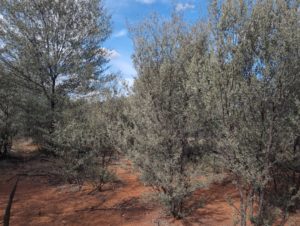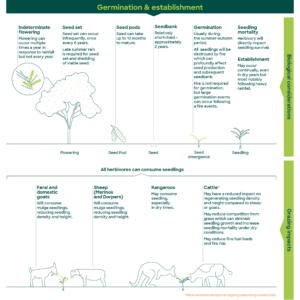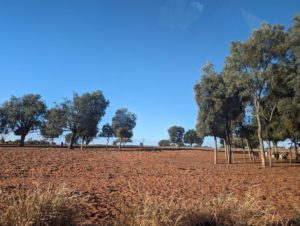There are ‘critical times’ that will help guide grazing management decisions for mulga – here is some guidance.
Grazing management is one of the key factors in the success of many carbon projects designed around the growth and regeneration of native vegetation. In this regard, management of timing or the extent of grazing are fundamental considerations.
Across Australia, mulga (Acacia aneura) is regarded as a highly valuable forage species, readily utilised by livestock that graze leaves and branches within reach, as well as recent leaf fall. It is one of the most widespread trees found across the arid and semi-arid regions of Australia, where it is either a dominant or co-dominant species [1]. Mulga is also a key species that regenerates within carbon projects.
Productivity within mulga communities is primarily driven by rainfall, though grazing and fire also have an impact on the growth and resilience of mulga woodlands [2].
Some of the main new types of grazing management currently being undertaken by land managers within the Carbon Estimation Areas (CEAs) of their projects include: management of feral goats; strategically resting paddocks; rotational grazing; and management of total grazing pressure. Often these management changes will be achieved through infrastructure upgrades to fences and waterpoints.
 There are ‘critical times’ when grazing management may provide opportunities to maximise the carbon sequestration within CEAs. The rate of regeneration can be influenced by the initial site condition, which largely includes the history of land use and past disturbances.
There are ‘critical times’ when grazing management may provide opportunities to maximise the carbon sequestration within CEAs. The rate of regeneration can be influenced by the initial site condition, which largely includes the history of land use and past disturbances.
Germination and establishment, as well as early growth of young plants, are two critical stages where grazing management can influence whether regeneration can occur and then persist under prevailing seasonal conditions. That is, when an all-to-infrequent set of seasonal conditions present an opportunity to maximise carbon sequestration in a project area, grazing management can influence both the short and long-term carbon outcome within the project CEAs.
Critical stage 1: Germination and establishment.
Mulga can flower multiple times throughout the year, but mostly during the warmer months [3], which contrasts to other species like hopbush (Dodonaea) or Emu bush (Eremophila) that tend to be more seasonal in their flowering pattern. Mulga will typically produce large volumes of seed in pulses, responding to episodic, above-average rainfall events [3]. While germination can occur throughout the year, germination during the summer-autumn period, even with low rainfall, will likely result in seedling survival over the winter period. The longer-term fate of these seedlings will, however, be determined by both the amount of rain experienced over the subsequent summer [3] and the grazing impact on the seedlings (<30 cm).
If the rainfall in the first summer is low, survival among mulga seedlings may be reduced and contingent on competition for soil moisture from ground cover species. If, on the other-hand, summer rainfall is adequate, mulga seedlings may survive against competition from ground cover species [5].
There is considerable evidence that grazing will directly impact palatable seedlings, like mulga, but the outcome will depend on the type of grazing animal. For example, sheep (Merinos and Dorpers) and goats are likely to have a severe impact on seedlings [6,7,8]. There is some evidence that cattle may have a more dampened impact on mulga seedling recruitment [9,10], which suggests cattle may play a potential role in regulating competition from ground cover experienced by mulga seedlings during the first summer growth period. However, there is no evidence that directly supports this, and this is something that GreenCollar’s Research and Development team are currently examining.
For palatable species, like mulga, successful recruitment and establishment will, where possible, require protection from all herbivores until newly establishing plants have lower branches beyond the browsing height of dominant herbivores. For example, sheep cannot generally reach branches higher than 1.2 m but, for both goats and cattle, this height is higher than 1.5 m. This means that while a cohort of mulga may be beyond the reach of sheep, regeneration may still be impacted by grazing when young mulga is greater than 1.2 m high. Cattle, in particular, may break down branches to access leaf material beyond 1.5 m high.
Critical stage 2: Growth
Studies in eastern Australia have shown that growth rates of grazed mulga can sometimes be half that of comparable ungrazed mulga [11,12]. Young mulga (less than 1.0 m heigh) has been reported to have mean growth rates of 0.23 m per year-1 [11], though there is large variation between individual trees within a stand. For example, in Cobar, the height growth of ungrazed areas ranged from 0.09 to 0.51 m per year-1.
The degree to which grazing will impact mulga regeneration and mature trees will depend on both the demand for forage from the total grazing pressure, as well as forage preferences between individual herbivore types. Total grazing pressure is the demand for feed relative to its supply, representing the combined grazing pressure from domestic livestock (sheep and cattle), feral (goats, pigs and rabbits) and native herbivores (such as kangaroos).
 When demand for feed exceeds supply, there is a negative impact on resource condition, such as ground cover [13], but also potential impacts on the amount of carbon stored in woody vegetation. When forage is unlimited, goats will spend 63% of their time grazing and only 28% browsing trees and shrubs. However the proportion of browse in goat diets will increase under dry conditions as they graze woody species not normally preferred [14].
When demand for feed exceeds supply, there is a negative impact on resource condition, such as ground cover [13], but also potential impacts on the amount of carbon stored in woody vegetation. When forage is unlimited, goats will spend 63% of their time grazing and only 28% browsing trees and shrubs. However the proportion of browse in goat diets will increase under dry conditions as they graze woody species not normally preferred [14].
This means that critical care of regenerating mulga within CEAs needs to consider the impact from total grazing pressure, particularly where seasonal conditions are deteriorating.
References
- [1] Randell BR (1992). Mulga. A revision of the major species. Journal of the Adelaide Botanic Gardens 14:105-132.
- [2] Nolan RH et al. (2019), Risks to carbon dynamics in semi-arid woodlands of eastern Australia under current and future climates. Journal of Environmental Management, 235: 500–510.
- [3] Preece PB (1971). Contributions to the biology of Mulga 1. Flowering. Australian Journal of Botany. 19. 21-38
- [4] Booth CA et al. (1996). Establishment of woody weeds in western New South Wales. 1. Seedling emergence and phenology. Rangeland Journal 18:58-79.
- [5] Harrington GN (1991). Effects of soil moisture on shrub seedling survival in a semi-arid grassland. Ecology 72:1138-1149.
- [6] Alemseged Y and Hacker RB (2014). Introduction of Dorper sheep into Australian rangelands: implications for production and natural resource management. The Rangeland Journal 36:85-90.
- [7] Pahl L (2019). Macropods, feral goats, sheep and cattle. 2. Equivalency in what and where they eat. The Rangeland Journal 41:519–533.
- [8] Squires VR (1982). Competitive interactions in the dietary preference of kangaroos and sheep, cattle and goats in inland Australia. Journal of Arid Environment 5:337-345.
- [9] Pressland AJ (1967). Possible effects of removal of mulga on rangeland stability in south western Queensland. Australian Rangeland Journal 1:24-30.
- [10] Fensham RJ et al. (2012). Potential above ground biomass in drought-prone forest used for pastoralism. Ecological Applications 22:894-908.
- [11] Brown RF (1985). The growth and survival of young mulga (Acacia aneura F. Muell) trees under different levels of grazing. Australian Rangeland Journal 7:143-148.
- [12] Cunningham GM and Walker PJ (1973). Growth and survival of mulga (Acacia aneura F. Muell. Ex Benth) in western New South Wales. Tropical grasslands 7:69-77.
- [13] Waters CM et al. (2019). Insights on the relationship between total grazing pressure management and sustainable land management: key indicators to verify impacts. The Rangeland Journal 41: 535–556.
- [14] Harrington GN (1986). Herbivore diet in a semi-arid Eucalyptus populnea woodland. 2. Feral goats. Australian Journal of Experimental Agriculture 26:423-429.











